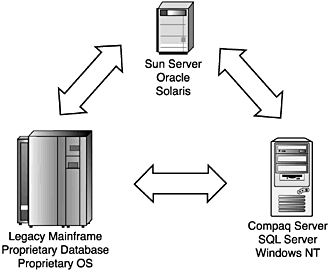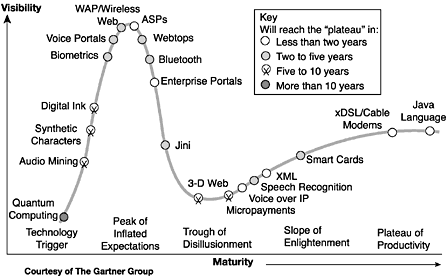The Origin of XML
| XML, just like HTML, is a derivative of the Standard Generalized Markup Language (SGML), which first made its appearance in the mid-1980s. SGML has revolutionized the publishing industry. If you want to read more about how SGML accomplished this and what it does for the publishing industry, there is an outstanding white paper on the Web at the following address: http://www.arbortext.com/data/getting_started_with_SGML/getting_started_with_sgml.html SGML is an international standard for the definition of device-independent, system-independent methods of representing text in electronic form, otherwise known as ISO 8879: Information ProcessingText and Office SystemsStandard Generalized Markup Language, ([Geneva]: ISO, 1986). More exactly, SGML is a metalanguage , a means of formally describing a language (in this case, a markup language). Before going any further, I will define these terms. Markup, or (synonymously) encoding, is defined as any means of making explicit an interpretation of a text. All printed texts are encoded in this sense: Punctuation marks, use of capitalization, disposition of letters around the page, and even the spaces between words might be regarded as a kind of markup. By a markup language, I mean a set of conventions used for encoding texts. A markup language must specify the following:
There are four characteristics of SGML that distinguish it from other markup languages:
The first three bullets are official concepts concerning SGML. The fourth is mine. The complexity of SGML led to the use of subsets of the SGML languageHTML and XML. We are all in one way or another familiar with HTML. If you listen to the hype surrounding it, XML has taken the place of the programming language Java, object technology, and probably several other technologies today as the global communication solution. It is touted as the duct tape that will allow all the disparate communications and data technologies, new or legacy, to communicate as if they were one homogenous business solution (see Figure 1.1). Figure 1.1. The XML promise. Do you ever find yourself thinking (and you will if you haven't already), "Boy, there sure is a lot of hype surrounding XML. I wonder if it'll really go anywhere ?" Stop and think about where Java itself was three years ago. That same soul searching was going on everywhere then. The hype surrounding Java has passed, and it is now providing enterprise solutions. The Gartner Group has developed what has become known as the Hype Chart. This chart (see Figure 1.2) shows a plot of various technologies in relation to their visibility and maturity. Looking at the placement of XML on this chart, you can see that it also is poised to become an enterprise tool very soon. Figure 1.2. The Hype Chart. |

